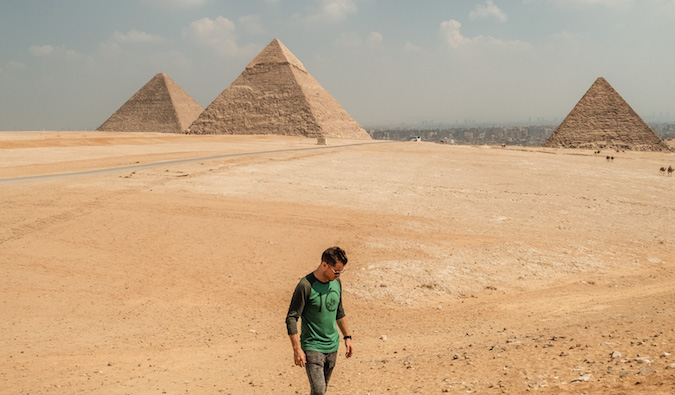 Posted
Posted: 2/3/2020 | February 3rd, 2020
One of the countries high up on my “must visit” list is Egypt. As a lover of history, I long to release my inner archaeologist and explore the many ruins of the country. While it might be a long time before I get there, my friend Jeremy Scott Foster from TravelFreak has visited a couple of times. In this guest post, he’ll give you his best tips for saving money on your next visit to Egypt!
I’ve been to
Egypt twice. On my first trip four years ago, I solo traveled the Sinai Peninsula along the Gulf of Aqaba, stayed in shared hostels for $5 USD per night and took overnight buses that cost just as little. On my most recent trip last year, I traveled from the very north of Egypt in Alexandria south to Cairo, and then further south along the Nile River to the border with Sudan.
And, throughout it all, I fall deeply in love with this country where foreign perception of violence keeps so many at arm’s length.
The tourism industry in Egypt is still feeling pain as a result of the political upheaval, civil unrest, and terrorism-related activities that have marred its recent history. As tourist numbers have dwindled and competition for the tourist dollar has become fiercer, travel deals have proliferated.
But what most visitors miss is what you can gain — free of crowds and for little money too.
From the chaos of Cairo to the more laid-back vibe of Luxor, Egypt is an ideal destination for budget travelers.
1. How to Save Money on Accommodation
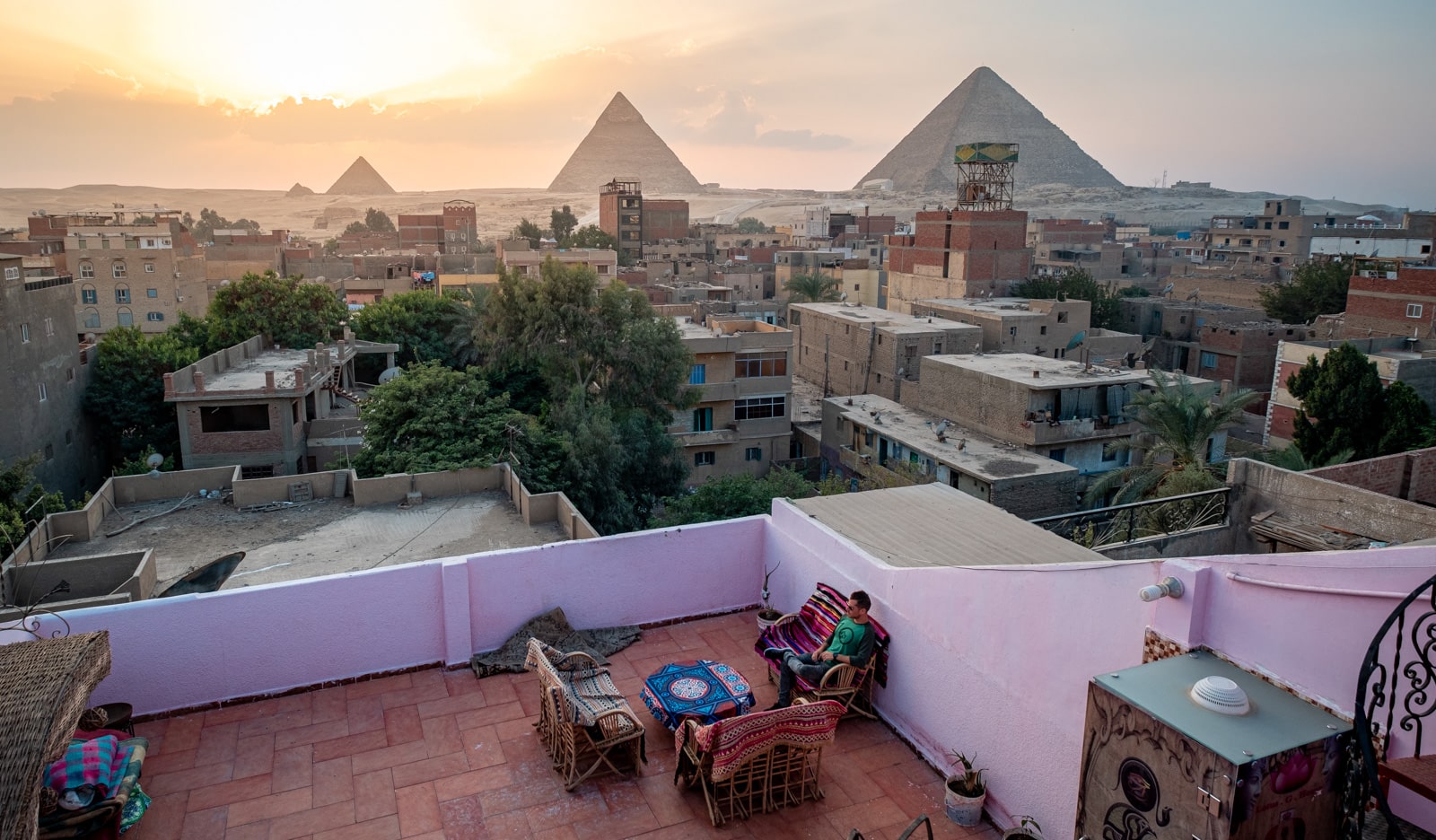
Generally speaking, accommodation in Egypt is relatively affordable. However, there are a few helpful tricks that can cut down your expenses.
Stay in hostels instead of hotels – Typically, you can expect to find a bed in a shared dorm room (with 4+ beds) for between $5-8 USD per night, or a comfortable private single room for about $15 USD per night. You will likely have to share a bathroom, but at least you have your privacy.
Use Hostelworld to look for the best prices. I recommend Dahab Hostel in Cairo and Al Salam Camp in Luxor.
Use Booking.com to compare prices for hotels – If you’re looking for cheap hotels or guesthouses in Egypt, I recommend checking Booking.com. A private room in a guesthouse or hotel goes for about $40 USD per night.
Prices are generally listed per room, not per person. So, if you are traveling with a friend, you can save even more money by splitting the cost.
Look for accommodations that add offer a little extra – I also found that, coupled with accommodation, it was pretty common for hosts in guesthouses to offer extras such as breakfast and local tours at very reasonable prices. One of my incredible hosts cooked a traditional hot breakfast with tea and coffee for just $1 USD. Best of all, he was more than happy to recommend some inexpensive local places to eat and buy food.
Look beyond the standard hotel rooms for accommodation options – Vrbo and HomeAway are great
Airbnb alternatives, as they’ve been connecting budget travelers and homeowners since the ’90s. HomeAway is geared towards people wanting a proper vacation rental, so you can expect a fully furnished home to live in which is great for longer stays.
Vrbo lets you stay in a local’s house, but at a slightly increased cost. You can usually find some pretty luxurious apartments starting from $50 USD per night.
The upside is that you’ll have full access to your own kitchen, which means you can further cut your costs by cooking at home.
2. How to Save Money on Food
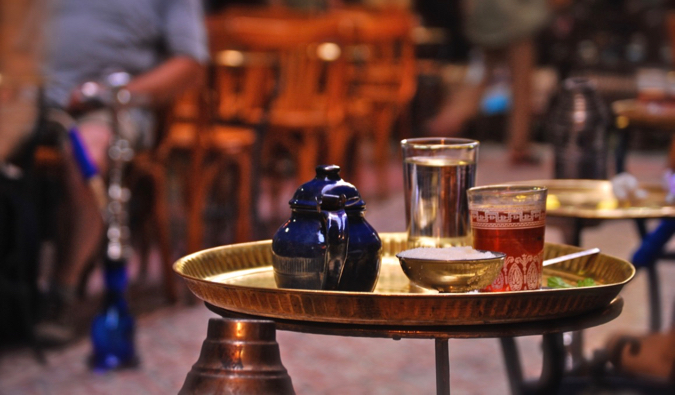 Stick to the local eats and street food –
Stick to the local eats and street food – If you want to save money on food while traveling in Egypt, do yourself a favor and steer clear of the Western chain food joints. While a cheeseburger is about half the price of what you pay at home, it’s still more expensive, less tasty, and far less adventurous than experiencing the local cuisine.
Why bother with a burger when you can eat the most delicious falafel in the world for $1 USD?
Navigate the narrow alleyways of any bustling Cairo market (like Khan El Khalili or Mohammed Ali Street) to seek out the best shawarma ($2 USD). Or grab a stuffed falafel sandwich from a street vendor on your way from one ancient relic to another ($2 USD). You can literally find Arabic bread for 5 cents. It’s all cheap and very filling.
And, the hummus. It’s so. Darn. Good.
If you’re staying at a guesthouse, it’s common practice for them to offer full dinners for about $10 USD. The truth is that they’re actually just sourcing the food from restaurants in the neighborhood and taking a cut, so by seeking out your own food options, expect to spend about ¼ of the price.
With that said,
don’t be afraid of street food or street vendors, especially if the food is cooked in front of you. And if there is a crowd of locals waiting, then chances are you’re onto a good thing.
Eat at a kosheri – A kosheri is a small, local restaurant that serves up generous portions of pasta, chickpeas, lentils, etc. often for less than $1 USD! There’s no menu, you just select the size of your portion and then you’re served this mishmash of deliciousness.
Cook your own meals – As mentioned, preparing your own meals while traveling is also a great money saver. If you have access to a kitchen, just ask your host to point you in the direction of the nearest market. They also have the lowdown on where to eat for cheap, so take advantage of their local knowledge!
3. How to Save Money on Transportation
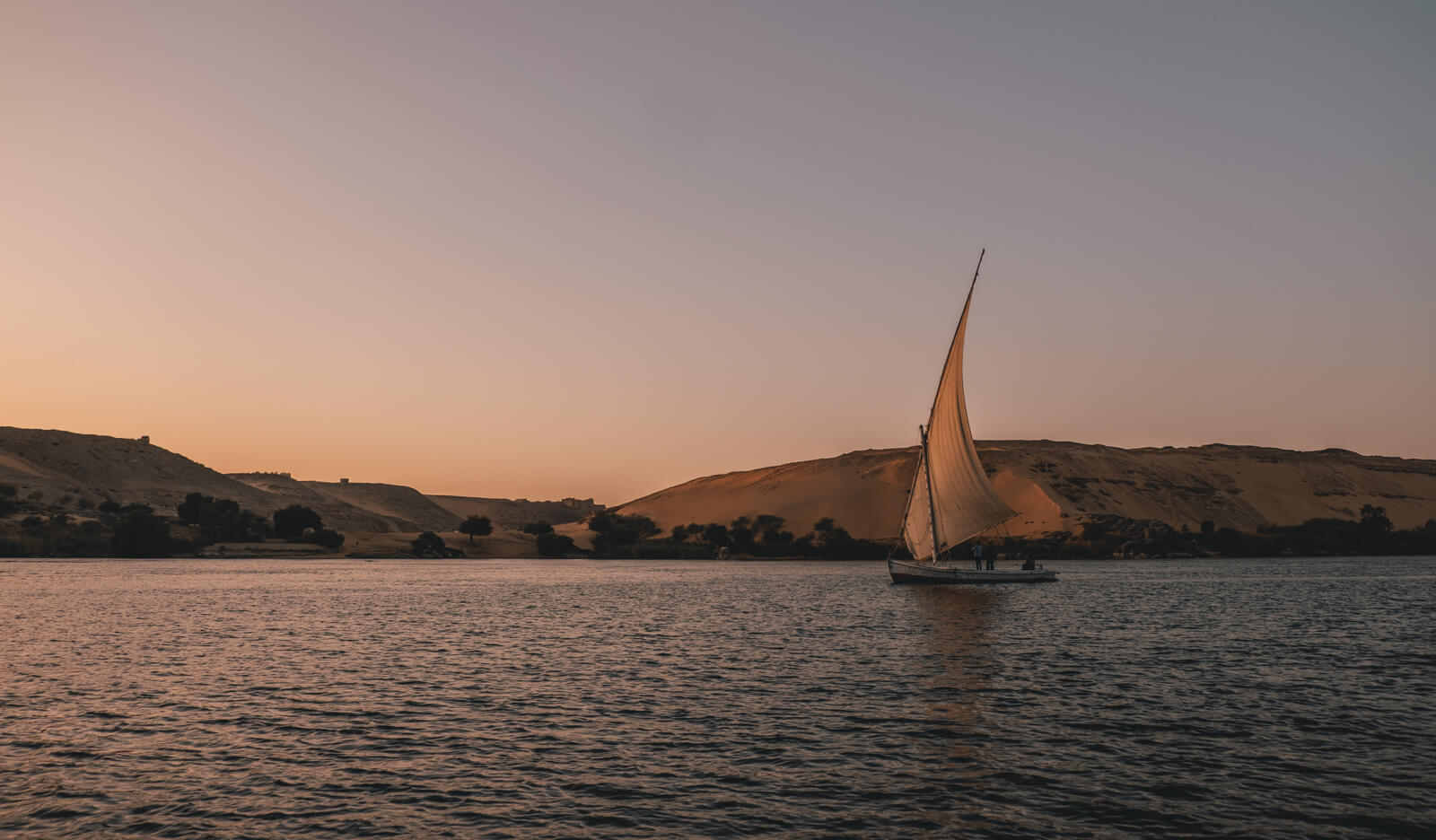 Bargain with your taxi driver –
Bargain with your taxi driver – In most Egyptian cities, taxis are an inexpensive and convenient way to get around.
Now, when I say convenient, I mean they’ll get you to where you need to go relatively quickly. But I would be remiss if I didn’t add a few disclaimers.
Taxi drivers can be aggressive on the road, leaving you white-knuckled from hanging on for dear life. I’ve never experienced a more heart-stopping journey than a Cairo taxi ride.
Furthermore, while Cairo does have metered taxis, don’t be lulled into a false sense of security. Meters are notoriously unreliable or rigged, and drivers frequently “forget” to turn them on. It’s one of the oldest
travel scams in the book.
The best practice is to use an unmetered taxi and agree on a price with the driver
before getting in. (Outside Cairo, most taxis are unmetered, so no matter what, always agree on a price upfront.)
If you’re not sure how much is an acceptable price, ask someone at your hostel or guesthouse for a pricing recommendation, and then start your bargaining at about ½ that price. Oftentimes even
they will give you a higher estimate than is normal (it’s locals helping locals), but the real price should be about ¾ of what you’ve been recommended.
For longer-distance trips, hiring a car with a driver is the most cost-effective option. The price will be the same whether you’re traveling by yourself or with a group of four, so round up some travel buddies and split the cost.
But of course, be prepared for some aggressive haggling to get the best price. Be clear about where you want to go and for how long you will need the driver. Don’t worry if negotiations break down, though. When it comes to haggling over price, never be afraid to walk away. There are plenty of drivers available, so just move on to the next one.
Take the local train – Taking the train between Alexandria, Cairo, Luxor, and Aswan is the most popular mode of transport for this route.
If time or budget is a concern, you can take an overnight train. By taking the sleeper train from Cairo to Luxor or Aswan, you’ll save a night’s worth of accommodation in a hotel. A deluxe sleeper cabin for one is about $110 USD, while a two-berth cabin is $80 USD per person. Cabins are secure, and fares include an airline-style dinner and breakfast. The food is basic, but it’s edible.
But for a
real bargain, you can book the day train between Cairo and Luxor or Aswan for as little as $10 USD. However, there’s one caveat: for safety reasons, the Egyptian government prohibits foreigners from purchasing day train tickets for this route. Officials say this is because only the night trains have armed guards in case of a terrorist attack, but this is an
incredibly rare occurrence.
It’s easy to get around this, though. You’ll need to book tickets online at
enr.gov.eg (you’ll have to register an account but it’s easy to do) or ask your guide, host, or driver to book the tickets for you. They will likely oblige for a small fee.
There are no reports of ticket attendants kicking any foreigners off the day train, so you’ll be fine. And if not, you’re only out $10 USD.
Get the Flight Pass – The fastest way to travel around Egypt is by plane. Egypt Air is the national carrier and Star Alliance Member serving most major domestic destinations. Its Flight Pass is a cost-effective option that allows you to lock in low fares for domestic flights even if you haven’t determined your travel dates.
All you have to do is purchase a minimum of four flights (or credits) and choose a time when you’d like to travel in the next 12 months. You can then book your flight up to seven days before departure.
On the downside, you’ll have to always fly back to your original departure point. That is, instead of flying from Cairo to Luxor and Alexandria, you’ll need to fly Cairo to Luxor and back to Cairo before going to Alexandria. That said, the Flight Pass is still about 30% cheaper than booking the same multi-destination flights with other airlines.
The Flight Pass is super customizable. You can select the number of flights (e.g. four, which is two round-trip flights) for a period of time (e.g. within one month), and also how early you can book your flights (e.g. one week before travel). This means that if you pick Cairo as your origin, you can select two round-trip flights to Aswan, Luxor, Alexandria, Sharm E Sheikh, or Hurghada. Each flight is $73 USD one-way.
But if I were to book a flight from Cairo to Luxor for one week from now, that same leg would cost at least $142 USD!
You can play around with this pass. For example, if you purchase a similar pass to the one above but select “one month” for how early you can book, the flights become $66 USD each per one-way.
If that’s too much of an inconvenience for you, there are plenty of other airlines offering affordable flights. When it comes to
finding cheap flights on other airlines, I use Skyscanner. By being flexible with your dates, you can save up to 50%. Keep in mind, though, that you might be traveling at inconvenient times, like the middle of the night.
In the
Skyscanner search bar, instead of entering specific dates, select the “Entire Month” option. This will show you a calendar with fare prices for departing and returning flights for every day of the month. This also works for one-way flights. However, it does not work for multicity flights.
4. How to Save Money on Tours and Guides

The best money-saving tip I can offer here is to avoid booking online before you arrive in Egypt.
If you’re a Type A traveler who needs a plan in hand before you even arrive, you’re not going to like this. But online agencies charge
massively inflated prices, and you will end up paying a lot less if you deal directly with the tour company or guide locally on the ground.
Add in the feel-good factor of your money going directly to your guide, their family, and community (and not to some middle person, agency, or large corporation) and you’ve got yourself a win-win situation.
You may need to be a little more flexible with your dates. But you will have the added advantage of being able to negotiate (haggle, in reality), which translates to overall savings.
Tours, private drivers, and the quintessential cruise down the Nile can all be booked locally at
significantly lower prices than booking in advance. So, if you can stomach it, wait until you get your boots on the ground before booking your tours.
Guides, in my experience, are an invaluable source of local knowledge and information. They have the inside scoop on the best vantage points for photos at all the epic landmarks. In addition, they’re great at dealing with those persistent and sometimes aggressive street vendors.
The best guides can be found by asking for recommendations from other travelers who have used their services, but I always recommend my Egyptian brother, Rami.
Back in 2015, on my first trip to Egypt, Rami and I connected by way of a mutual friend. We hit it off, and ever since then, I’ve helped him to grow the little tour business he and his family-run. It feels good to be able to help a local family in such a positive way.
He’s honest, affordable, reliable, incredibly communicative, well connected, and did I mention honest? That’s one of the difficult parts about traveling in places like Egypt: when people are selling you things, it’s hard to know who you can trust.
But Rami is my man. Send him an email at
ramielshaer2@gmail.com and let him know Jeremy sent you (there are no commissions here — this is just a helpful referral to a well-deserving friend). He will sort you out or put you in touch with someone else in your preferred destination.
5. How to Save Money on Entrance and Admission Fees
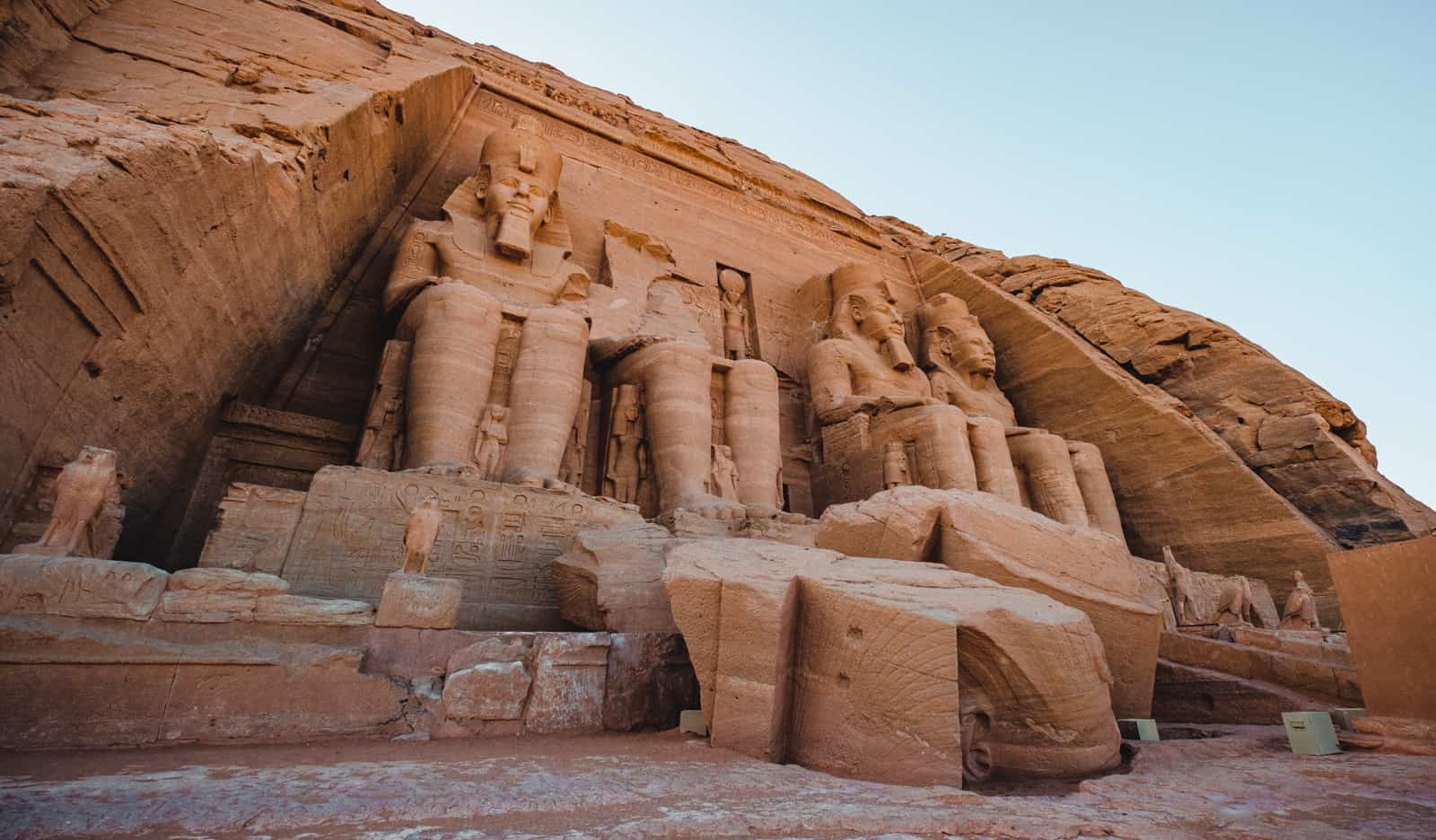 Get the International Student Identity Card –
Get the International Student Identity Card – Entrance and admission prices for almost all monuments and attractions in Egypt are set as advertised. However, you can get discounted tickets with an International Student Identity Card, including 50% off some of Egypt’s best museums (including the Luxor).
Get a travel pass – You can get a Cairo Pass or a Luxor Pass (multi-entrance discount passes) from the Ministry of Antiquities, the Egyptian Museum, or the Giza Plateau for about $80 USD. You’ll save about 50% off entries to over 30 attractions in Cairo and Giza. You’ll find very little information about these passes online, however, so your best bet is to just show up at one of those locations and inquire there.
Suggested Budgets for Traveling in Egypt
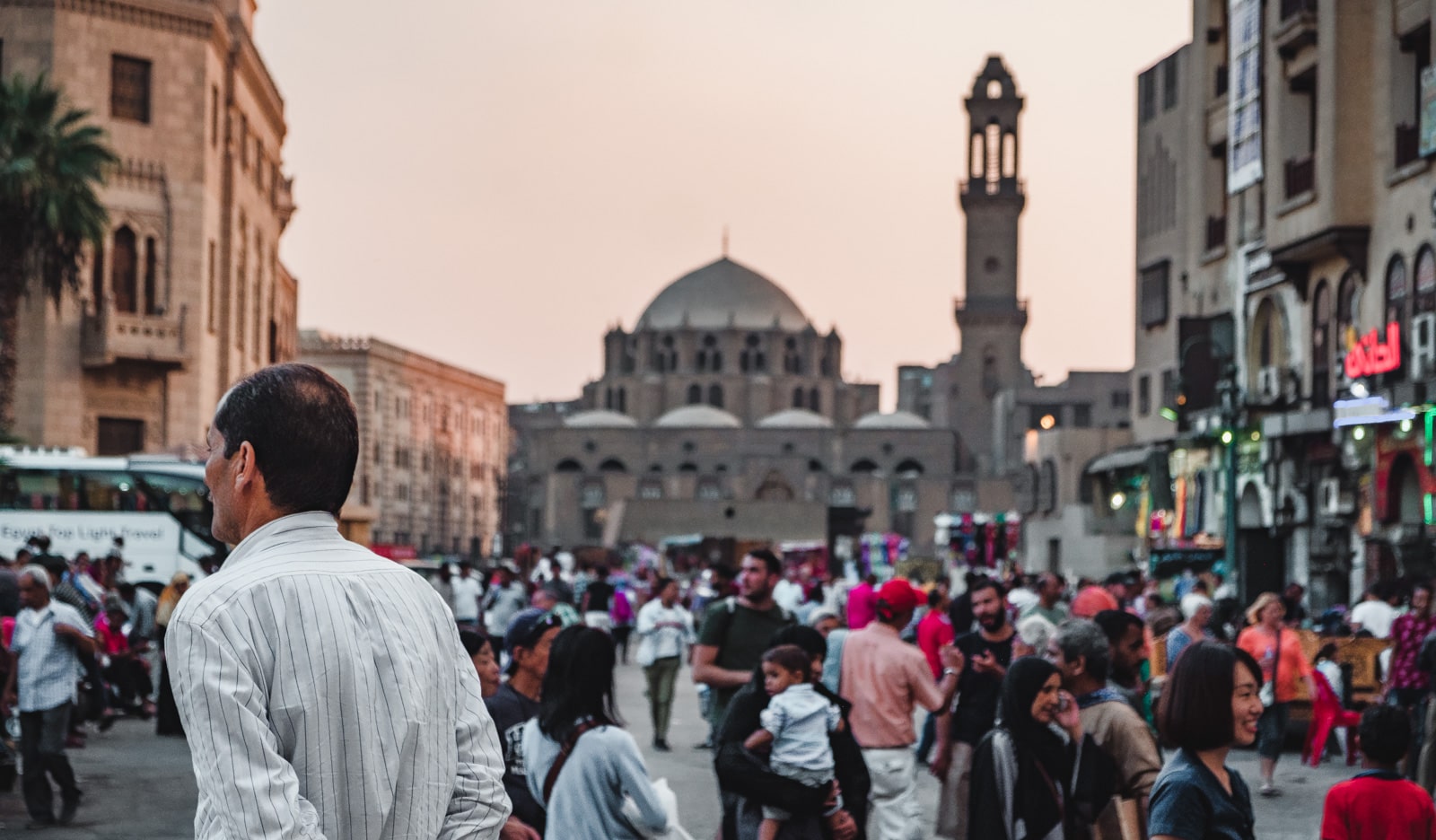
While you can spend money on luxury resorts or private tours, it’s entirely possible to travel through Egypt on the cheap. In fact, you can easily spend as little as $30-$35 USD a day.
The biggest way to reduce costs is to stay in dorm rooms or hostels. If you opt for a private room or mid-range hotel, you can expect to spend $30-40 USD
more per night.
Where and what you eat also adds to your daily budget. For example, street food is an affordable and filling option for dining in Egypt. You can eat everything from falafel and sandwiches to shawarma and koshari noodles for as little as $1 USD.
Eating in a restaurant is more expensive, but still relatively cheap compared to Western countries. Meals in a mid-range restaurant start at $4 USD, while international dishes can be around $10 USD.
Transportation is another added cost. Train travel can be cheap but may not be the most efficient option if your time is limited. So, if you plan to fly between your destinations, expect to add $50-$100 USD to your budget for each flight.
Of course, your daily budget will also increase if you book private guides or splurge on souvenirs and gifts.
And remember, haggling is one of the most important skills if you’re looking to save money in Egypt. Taxis, excursions, and other services can usually be bargained down to a lower rate than what is initially quoted. So, if you have a high tolerance for haggling, your daily budget could easily be less.
Regardless, it’s always better to go slightly over budget, especially somewhere with as many must-see sights and experiences as Egypt!
***
The key to budget travel in Egypt is to be generally well informed and to have a good sense of humor (the latter goes a
long way when dealing with vendors). Haggling and scammers are all part of everyday travel life in Egypt. There are very few goods and services that can’t be bargained for.
Most importantly, always, ALWAYS ask for and agree on a price first before accepting any goods or services. Most importantly, don’t be afraid to politely say no and walk away.
Now it’s time to start planning your trip to
Egypt for maximum adventures at minimum cost in the land of Pharaohs, pyramids, and wonders of the ancient world. Get to it!
Jeremy is the adventurous traveler behind TravelFreak, a website dedicated to helping people create lives they are passionate about. You can check out his blog to learn more or find him on Facebook, Instagram, and Twitter.
Book Your Trip: Logistical Tips and Tricks
Book Your Flight
Find a cheap flight by using
Skyscanner or
Momondo. They are my two favorite search engines because they search websites and airlines around the globe so you always know no stone is left unturned.
Book Your Accommodation
You can book your hostel with
Hostelworld as they have the largest inventory. If you want to stay somewhere other than a hostel, use
Booking.com as they consistently return the cheapest rates for guesthouses and cheap hotels. I use them all the time. Some suggested hostels to stay at are:
Dahab Hostel
(Cairo) – The rooms are basic but the owner is friendly and helfpful and the hostel is in a great location.
- Al Salam Camp (Luxor) – Great location and incredible staff. it’s away from the noise of the city and a great place to relax and meet other travelers.
Don’t Forget Travel Insurance
Travel insurance will protect you against illness, injury, theft, and cancellations. It’s comprehensive protection in case anything goes wrong. I never go on a trip without it as I’ve had to use it many times in the past. I’ve been using
World Nomads for ten years. My favorite companies that offer the best service and value are:
Looking for the best companies to save money with?
Check out my
resource page for the best companies to use when you travel! I list all the ones I use to save money when I travel – and that will save you time and money too!
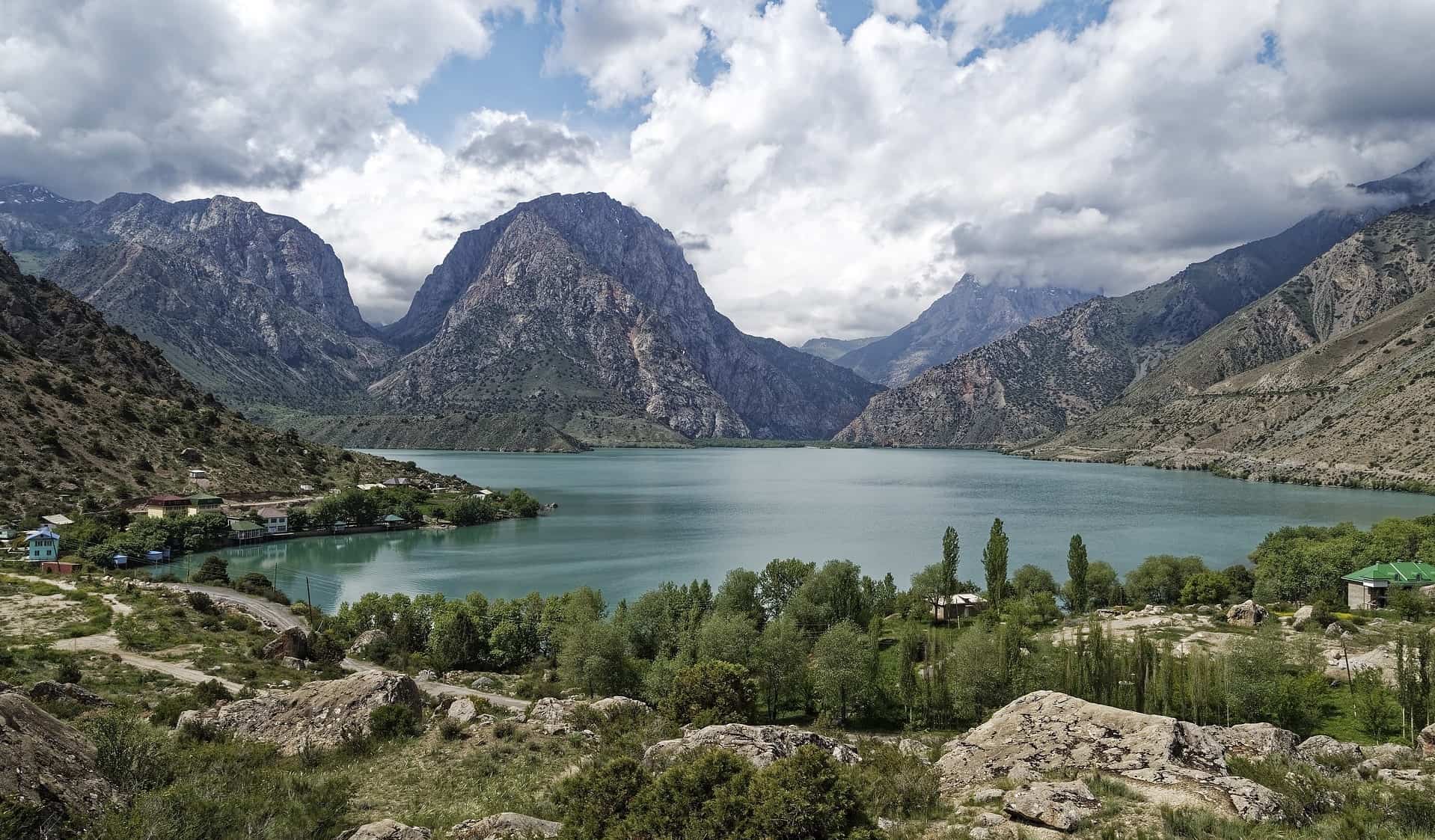 This year, I’m going to try to visit Central Asia in the fall. I’ve never been to the region and it’s long one that’s held great appeal to me. It seems raw, beautiful, and unspoiled. So, when someone reached out to write a guest post on a country there, I was excited. It was a chance to learn a little before I (hopefully) go. In this guest post, traveler and writer Paul McDougal breaks down what it’s like to travel Tajikistan on a budget.
Aptly and romantically known as “The Roof of the World,” Tajikistan is a hikers’ paradise. More than 93% of the country is defined as mountainous — and more than 50% of that sits at over 3,000 meters (9,800 feet)! It’s a striking country, full of glacial peaks and mountain lakes that are best for multiday hikes (but equally astounding on short jaunts too).
Traveling around Tajikistan requires a sense of adventure, as the nation is also dotted with poor-quality roads, rudimentary facilities, and a massive lack of infrastructure. But, after spending almost a month there, I learned that it’s easy and affordable to get around these problems with a smile and a shrug.
Many tourists spend more money than necessary when in Tajikistan. Most do so on an organized tour, which is why there’s a prevailing — and inaccurate — idea that it’s expensive to visit the country. A ten-day organized tour booked online can cost anywhere from $1,500 to $3,500 USD, equivalent to a hefty $150-350 a day.
But if you travel independently, you can easily navigate this country for about $45 USD per day.
So, how do you see Tajikistan on a budget? Here’s how:
This year, I’m going to try to visit Central Asia in the fall. I’ve never been to the region and it’s long one that’s held great appeal to me. It seems raw, beautiful, and unspoiled. So, when someone reached out to write a guest post on a country there, I was excited. It was a chance to learn a little before I (hopefully) go. In this guest post, traveler and writer Paul McDougal breaks down what it’s like to travel Tajikistan on a budget.
Aptly and romantically known as “The Roof of the World,” Tajikistan is a hikers’ paradise. More than 93% of the country is defined as mountainous — and more than 50% of that sits at over 3,000 meters (9,800 feet)! It’s a striking country, full of glacial peaks and mountain lakes that are best for multiday hikes (but equally astounding on short jaunts too).
Traveling around Tajikistan requires a sense of adventure, as the nation is also dotted with poor-quality roads, rudimentary facilities, and a massive lack of infrastructure. But, after spending almost a month there, I learned that it’s easy and affordable to get around these problems with a smile and a shrug.
Many tourists spend more money than necessary when in Tajikistan. Most do so on an organized tour, which is why there’s a prevailing — and inaccurate — idea that it’s expensive to visit the country. A ten-day organized tour booked online can cost anywhere from $1,500 to $3,500 USD, equivalent to a hefty $150-350 a day.
But if you travel independently, you can easily navigate this country for about $45 USD per day.
So, how do you see Tajikistan on a budget? Here’s how:
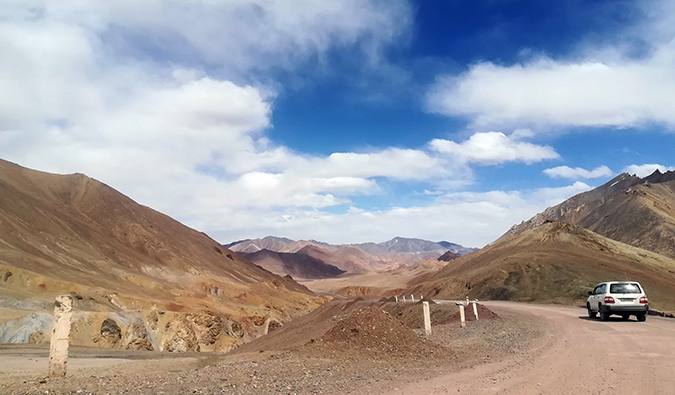 Instead of booking a tour through an online agent, you have four much more affordable ways to get around to choose from:
1. Find a multiday driver when you arrive
Hostels and guesthouses can put you in contact with local drivers, with whom you can negotiate your own rate, itinerary, and trip length. Typically, travelers spend $50-100 per day per person for this. The better your negotiation skills (and the more stubborn you are), the greater the chance you’ll get a driver for closer to $50 a day.
Drivers can be found in Murghab, Khorog, Dushanbe, and other larger places. If you’re traveling the Pamir Highway (like pretty much everyone else in Tajikistan), you can also find drivers in Kyrgyzstan’s second-biggest city, Osh.
2. Hire a 4WD yourself
This typically costs around $100 per day for the vehicle, so if you’re traveling with a few people, this is a great choice. It gives you freedom and it’s good for your budget!
It’s very easy to organize this upon arrival. All hotels, hostels, and guesthouses in both Osh and Dushanbe can put you into contact with agencies that can arrange 4WD rentals. Don’t arrange this online, unless you want to spend more money.
3. Public transport
Long-distance public transport doesn’t really exist in Tajikistan. However, enterprising locals have filled this gap in a very affordable way. Every day, before they travel from one city or town to another to go about their daily business, they always ensure that every single spot in their vehicle is filled.
To find these travel opportunities, ask your guesthouse where “the bus station” is. They’ll direct you to a car-crammed area (usually near a market) where there will be drivers waiting to fill their cars. Using this method, it’s not unusual to end up squashed into the back of an ancient car with four other people on a five-hour trip. These trips typically only costs around $10. And it’s a great way to immerse yourself in local life.
The price of the trip depends upon its length. The most I paid was for any single trip was $35 USD for a 12-hour, 600-mile voyage from Khorog to Dushanbe. And that was in a 4WD.
A quick side note: If you’re traveling within a city or town, there are many small minibuses (marshrutkas) that can take you from one destination to another along prescribed routes for the measly price of around $0.20 USD. But along those routes, they’ll stop anywhere to take on new passengers and drop off others. And I mean anywhere: houses, outdoor markets, the middle of busy roads — it’s all fair game.
4. Hitchhiking
For the vast majority of my trips in Tajikistan, I hitchhiked. Local people hitchhike in Tajikistan every single day — it’s a valid, recognized method of transport here as not every has a car and, as mentioned above, public transportation is scarce.
When you hitchhike in Tajikistan, don’t stick out your thumb. Keep your stretched-out hand parallel to the ground and wave it up and down. Depending on where you’re hitchhiking, you will probably have to wait a while — on some barren stretches of road, you might wait thirty minutes to see one car. But, if that car has an empty spot, it will stop and take you without fail. (You might have to pay a little money.)
I experienced nothing but positivity and warmth doing this. People were happy to take me and introduced me to all sorts of Tajik food, drinks, and music. It’s not unusual for those who pick you up to offer you snacks, buy you a meal, or take you to their home. I always offered money in return for these treats, but it was never accepted.
Instead of booking a tour through an online agent, you have four much more affordable ways to get around to choose from:
1. Find a multiday driver when you arrive
Hostels and guesthouses can put you in contact with local drivers, with whom you can negotiate your own rate, itinerary, and trip length. Typically, travelers spend $50-100 per day per person for this. The better your negotiation skills (and the more stubborn you are), the greater the chance you’ll get a driver for closer to $50 a day.
Drivers can be found in Murghab, Khorog, Dushanbe, and other larger places. If you’re traveling the Pamir Highway (like pretty much everyone else in Tajikistan), you can also find drivers in Kyrgyzstan’s second-biggest city, Osh.
2. Hire a 4WD yourself
This typically costs around $100 per day for the vehicle, so if you’re traveling with a few people, this is a great choice. It gives you freedom and it’s good for your budget!
It’s very easy to organize this upon arrival. All hotels, hostels, and guesthouses in both Osh and Dushanbe can put you into contact with agencies that can arrange 4WD rentals. Don’t arrange this online, unless you want to spend more money.
3. Public transport
Long-distance public transport doesn’t really exist in Tajikistan. However, enterprising locals have filled this gap in a very affordable way. Every day, before they travel from one city or town to another to go about their daily business, they always ensure that every single spot in their vehicle is filled.
To find these travel opportunities, ask your guesthouse where “the bus station” is. They’ll direct you to a car-crammed area (usually near a market) where there will be drivers waiting to fill their cars. Using this method, it’s not unusual to end up squashed into the back of an ancient car with four other people on a five-hour trip. These trips typically only costs around $10. And it’s a great way to immerse yourself in local life.
The price of the trip depends upon its length. The most I paid was for any single trip was $35 USD for a 12-hour, 600-mile voyage from Khorog to Dushanbe. And that was in a 4WD.
A quick side note: If you’re traveling within a city or town, there are many small minibuses (marshrutkas) that can take you from one destination to another along prescribed routes for the measly price of around $0.20 USD. But along those routes, they’ll stop anywhere to take on new passengers and drop off others. And I mean anywhere: houses, outdoor markets, the middle of busy roads — it’s all fair game.
4. Hitchhiking
For the vast majority of my trips in Tajikistan, I hitchhiked. Local people hitchhike in Tajikistan every single day — it’s a valid, recognized method of transport here as not every has a car and, as mentioned above, public transportation is scarce.
When you hitchhike in Tajikistan, don’t stick out your thumb. Keep your stretched-out hand parallel to the ground and wave it up and down. Depending on where you’re hitchhiking, you will probably have to wait a while — on some barren stretches of road, you might wait thirty minutes to see one car. But, if that car has an empty spot, it will stop and take you without fail. (You might have to pay a little money.)
I experienced nothing but positivity and warmth doing this. People were happy to take me and introduced me to all sorts of Tajik food, drinks, and music. It’s not unusual for those who pick you up to offer you snacks, buy you a meal, or take you to their home. I always offered money in return for these treats, but it was never accepted.
 1. Guesthouses
In any town or city, you’ll see houses with the word “guesthouse” written on them. Go inside one and strike a deal. It’s the easiest and most affordable accommodation, the perfect way to save money and have a better experience. You’ll be given great food and an even greater welcome.
Throughout Tajikistan, local people will let you stay in their home for around $10-15 a night. This usually will cover breakfast and dinner too. You can negotiate lunch for a little more if you like — or you can eat elsewhere. Most guesthouses offer much the same welcome and much the same food, so it doesn’t really matter which you choose.
Often, if you’re in a car with Tajiks (whether through hitchhiking or other means), they’ll take you a guesthouse they know of. And it’ll usually be a good one so don’t be too worried about scams.
And even if you can’t find an official guesthouse, you’ll find a friendly local who’ll let you stay at their home for a small price.
2. Hotels and hostels
These can be equally budget-friendly if you choose the right places. Some hotels are very expensive, but spots such as Pamir Hotel in Murghab offer affordable stays starting at around $15 USD a night. Some smaller towns such as Jelondy, a popular hot spring spot for locals, also offer hotel stays for around $10 USD. (Generally speaking, if a town is a popular vacation spot for Tajiks, there will be a cheap hotel.)
Hostels are a good cheap option in bigger towns and cities, and especially in Dushanbe. Green House Hostel in particular is a fantastic, affordable hub and is packed with travelers. It’s an excellent place to team up with others to save on transport costs.
3. Camping
Your third option for accommodation is camping. In some ways, Tajikistan is very camper friendly. I’m not sure what the actual laws are on wild camping, but I’d be very surprised if any exist. Although I didn’t do so myself, I met many people who camped in the wild, and none of them encountered any trouble. You should, of course, follow the normal rules of wild camping: don’t camp in the same place for more than one night, don’t camp on private land without permission, and don’t camp in cities. You should also research whether there are any dangers in the particular area you’re keen to camp. But otherwise, you will not draw any attention, since camping is very well tolerated here.
Moreover, guesthouses and hotels will often let you pitch your tent on their land for only $2 or $3 USD.
Note: the harsh weather conditions can often make camping an unpleasant experience. Because much of Tajikistan lies at such a high elevation, the temperatures can be unpleasant and even dangerous — and the ground in some conditions can be too tough to push tent pegs into. So you should be careful when planning where you want to camp.
1. Guesthouses
In any town or city, you’ll see houses with the word “guesthouse” written on them. Go inside one and strike a deal. It’s the easiest and most affordable accommodation, the perfect way to save money and have a better experience. You’ll be given great food and an even greater welcome.
Throughout Tajikistan, local people will let you stay in their home for around $10-15 a night. This usually will cover breakfast and dinner too. You can negotiate lunch for a little more if you like — or you can eat elsewhere. Most guesthouses offer much the same welcome and much the same food, so it doesn’t really matter which you choose.
Often, if you’re in a car with Tajiks (whether through hitchhiking or other means), they’ll take you a guesthouse they know of. And it’ll usually be a good one so don’t be too worried about scams.
And even if you can’t find an official guesthouse, you’ll find a friendly local who’ll let you stay at their home for a small price.
2. Hotels and hostels
These can be equally budget-friendly if you choose the right places. Some hotels are very expensive, but spots such as Pamir Hotel in Murghab offer affordable stays starting at around $15 USD a night. Some smaller towns such as Jelondy, a popular hot spring spot for locals, also offer hotel stays for around $10 USD. (Generally speaking, if a town is a popular vacation spot for Tajiks, there will be a cheap hotel.)
Hostels are a good cheap option in bigger towns and cities, and especially in Dushanbe. Green House Hostel in particular is a fantastic, affordable hub and is packed with travelers. It’s an excellent place to team up with others to save on transport costs.
3. Camping
Your third option for accommodation is camping. In some ways, Tajikistan is very camper friendly. I’m not sure what the actual laws are on wild camping, but I’d be very surprised if any exist. Although I didn’t do so myself, I met many people who camped in the wild, and none of them encountered any trouble. You should, of course, follow the normal rules of wild camping: don’t camp in the same place for more than one night, don’t camp on private land without permission, and don’t camp in cities. You should also research whether there are any dangers in the particular area you’re keen to camp. But otherwise, you will not draw any attention, since camping is very well tolerated here.
Moreover, guesthouses and hotels will often let you pitch your tent on their land for only $2 or $3 USD.
Note: the harsh weather conditions can often make camping an unpleasant experience. Because much of Tajikistan lies at such a high elevation, the temperatures can be unpleasant and even dangerous — and the ground in some conditions can be too tough to push tent pegs into. So you should be careful when planning where you want to camp.
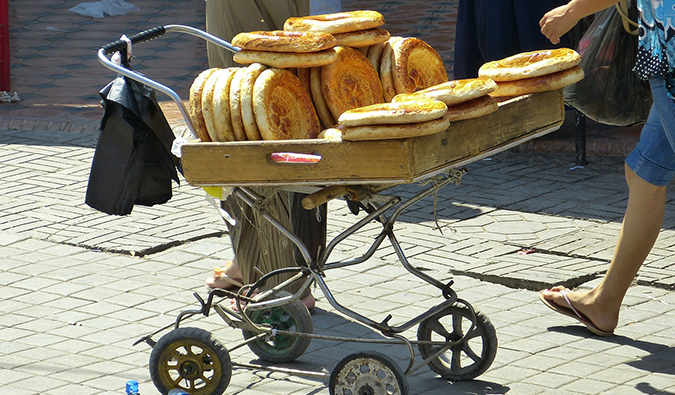 Everyone gets sick in Tajikistan. I have the world’s strongest stomach, and even I got sick on three separate occasions. You should also wash your hands as much as possible and avoid putting them into your mouth after handling money. And don’t drink the tap water!
Everyone gets sick in Tajikistan. I have the world’s strongest stomach, and even I got sick on three separate occasions. You should also wash your hands as much as possible and avoid putting them into your mouth after handling money. And don’t drink the tap water!
 here and follow his Instagram here for photography and scenes from the road.
P.S. – Want to meet other travelers in real life? This year we launched The Nomadic Network, a platform created to help travelers connect, learn, and get inspired in real life! Here are our upcoming events if you want to take part: Seattle (2/17), Austin (2/18), Fort Lauderdale (2/19), Portland (2/19), San Francisco (2/20), Los Angeles (2/23), Detroit (2/24), Boston (2/24), Dublin (2/24), San Diego (2/24), London (2/25), Chicago (2/25), and NYC (3/10).
here and follow his Instagram here for photography and scenes from the road.
P.S. – Want to meet other travelers in real life? This year we launched The Nomadic Network, a platform created to help travelers connect, learn, and get inspired in real life! Here are our upcoming events if you want to take part: Seattle (2/17), Austin (2/18), Fort Lauderdale (2/19), Portland (2/19), San Francisco (2/20), Los Angeles (2/23), Detroit (2/24), Boston (2/24), Dublin (2/24), San Diego (2/24), London (2/25), Chicago (2/25), and NYC (3/10).
 Posted: 2/3/2020 | February 3rd, 2020
One of the countries high up on my “must visit” list is Egypt. As a lover of history, I long to release my inner archaeologist and explore the many ruins of the country. While it might be a long time before I get there, my friend Jeremy Scott Foster from
Posted: 2/3/2020 | February 3rd, 2020
One of the countries high up on my “must visit” list is Egypt. As a lover of history, I long to release my inner archaeologist and explore the many ruins of the country. While it might be a long time before I get there, my friend Jeremy Scott Foster from  Generally speaking, accommodation in Egypt is relatively affordable. However, there are a few helpful tricks that can cut down your expenses.
Stay in hostels instead of hotels – Typically, you can expect to find a bed in a shared dorm room (with 4+ beds) for between $5-8 USD per night, or a comfortable private single room for about $15 USD per night. You will likely have to share a bathroom, but at least you have your privacy.
Use Hostelworld to look for the best prices. I recommend Dahab Hostel in Cairo and Al Salam Camp in Luxor.
Use Booking.com to compare prices for hotels – If you’re looking for cheap hotels or guesthouses in Egypt, I recommend checking Booking.com. A private room in a guesthouse or hotel goes for about $40 USD per night.
Prices are generally listed per room, not per person. So, if you are traveling with a friend, you can save even more money by splitting the cost.
Look for accommodations that add offer a little extra – I also found that, coupled with accommodation, it was pretty common for hosts in guesthouses to offer extras such as breakfast and local tours at very reasonable prices. One of my incredible hosts cooked a traditional hot breakfast with tea and coffee for just $1 USD. Best of all, he was more than happy to recommend some inexpensive local places to eat and buy food.
Look beyond the standard hotel rooms for accommodation options –
Generally speaking, accommodation in Egypt is relatively affordable. However, there are a few helpful tricks that can cut down your expenses.
Stay in hostels instead of hotels – Typically, you can expect to find a bed in a shared dorm room (with 4+ beds) for between $5-8 USD per night, or a comfortable private single room for about $15 USD per night. You will likely have to share a bathroom, but at least you have your privacy.
Use Hostelworld to look for the best prices. I recommend Dahab Hostel in Cairo and Al Salam Camp in Luxor.
Use Booking.com to compare prices for hotels – If you’re looking for cheap hotels or guesthouses in Egypt, I recommend checking Booking.com. A private room in a guesthouse or hotel goes for about $40 USD per night.
Prices are generally listed per room, not per person. So, if you are traveling with a friend, you can save even more money by splitting the cost.
Look for accommodations that add offer a little extra – I also found that, coupled with accommodation, it was pretty common for hosts in guesthouses to offer extras such as breakfast and local tours at very reasonable prices. One of my incredible hosts cooked a traditional hot breakfast with tea and coffee for just $1 USD. Best of all, he was more than happy to recommend some inexpensive local places to eat and buy food.
Look beyond the standard hotel rooms for accommodation options –  Stick to the local eats and street food – If you want to save money on food while traveling in Egypt, do yourself a favor and steer clear of the Western chain food joints. While a cheeseburger is about half the price of what you pay at home, it’s still more expensive, less tasty, and far less adventurous than experiencing the local cuisine.
Why bother with a burger when you can eat the most delicious falafel in the world for $1 USD?
Navigate the narrow alleyways of any bustling Cairo market (like Khan El Khalili or Mohammed Ali Street) to seek out the best shawarma ($2 USD). Or grab a stuffed falafel sandwich from a street vendor on your way from one ancient relic to another ($2 USD). You can literally find Arabic bread for 5 cents. It’s all cheap and very filling.
And, the hummus. It’s so. Darn. Good.
If you’re staying at a guesthouse, it’s common practice for them to offer full dinners for about $10 USD. The truth is that they’re actually just sourcing the food from restaurants in the neighborhood and taking a cut, so by seeking out your own food options, expect to spend about ¼ of the price.
With that said,
Stick to the local eats and street food – If you want to save money on food while traveling in Egypt, do yourself a favor and steer clear of the Western chain food joints. While a cheeseburger is about half the price of what you pay at home, it’s still more expensive, less tasty, and far less adventurous than experiencing the local cuisine.
Why bother with a burger when you can eat the most delicious falafel in the world for $1 USD?
Navigate the narrow alleyways of any bustling Cairo market (like Khan El Khalili or Mohammed Ali Street) to seek out the best shawarma ($2 USD). Or grab a stuffed falafel sandwich from a street vendor on your way from one ancient relic to another ($2 USD). You can literally find Arabic bread for 5 cents. It’s all cheap and very filling.
And, the hummus. It’s so. Darn. Good.
If you’re staying at a guesthouse, it’s common practice for them to offer full dinners for about $10 USD. The truth is that they’re actually just sourcing the food from restaurants in the neighborhood and taking a cut, so by seeking out your own food options, expect to spend about ¼ of the price.
With that said,  Bargain with your taxi driver – In most Egyptian cities, taxis are an inexpensive and convenient way to get around.
Now, when I say convenient, I mean they’ll get you to where you need to go relatively quickly. But I would be remiss if I didn’t add a few disclaimers.
Taxi drivers can be aggressive on the road, leaving you white-knuckled from hanging on for dear life. I’ve never experienced a more heart-stopping journey than a Cairo taxi ride.
Furthermore, while Cairo does have metered taxis, don’t be lulled into a false sense of security. Meters are notoriously unreliable or rigged, and drivers frequently “forget” to turn them on. It’s one of the oldest
Bargain with your taxi driver – In most Egyptian cities, taxis are an inexpensive and convenient way to get around.
Now, when I say convenient, I mean they’ll get you to where you need to go relatively quickly. But I would be remiss if I didn’t add a few disclaimers.
Taxi drivers can be aggressive on the road, leaving you white-knuckled from hanging on for dear life. I’ve never experienced a more heart-stopping journey than a Cairo taxi ride.
Furthermore, while Cairo does have metered taxis, don’t be lulled into a false sense of security. Meters are notoriously unreliable or rigged, and drivers frequently “forget” to turn them on. It’s one of the oldest  The best money-saving tip I can offer here is to avoid booking online before you arrive in Egypt.
If you’re a Type A traveler who needs a plan in hand before you even arrive, you’re not going to like this. But online agencies charge massively inflated prices, and you will end up paying a lot less if you deal directly with the tour company or guide locally on the ground.
Add in the feel-good factor of your money going directly to your guide, their family, and community (and not to some middle person, agency, or large corporation) and you’ve got yourself a win-win situation.
You may need to be a little more flexible with your dates. But you will have the added advantage of being able to negotiate (haggle, in reality), which translates to overall savings.
Tours, private drivers, and the quintessential cruise down the Nile can all be booked locally at significantly lower prices than booking in advance. So, if you can stomach it, wait until you get your boots on the ground before booking your tours.
Guides, in my experience, are an invaluable source of local knowledge and information. They have the inside scoop on the best vantage points for photos at all the epic landmarks. In addition, they’re great at dealing with those persistent and sometimes aggressive street vendors.
The best guides can be found by asking for recommendations from other travelers who have used their services, but I always recommend my Egyptian brother, Rami.
Back in 2015, on my first trip to Egypt, Rami and I connected by way of a mutual friend. We hit it off, and ever since then, I’ve helped him to grow the little tour business he and his family-run. It feels good to be able to help a local family in such a positive way.
He’s honest, affordable, reliable, incredibly communicative, well connected, and did I mention honest? That’s one of the difficult parts about traveling in places like Egypt: when people are selling you things, it’s hard to know who you can trust.
But Rami is my man. Send him an email at
The best money-saving tip I can offer here is to avoid booking online before you arrive in Egypt.
If you’re a Type A traveler who needs a plan in hand before you even arrive, you’re not going to like this. But online agencies charge massively inflated prices, and you will end up paying a lot less if you deal directly with the tour company or guide locally on the ground.
Add in the feel-good factor of your money going directly to your guide, their family, and community (and not to some middle person, agency, or large corporation) and you’ve got yourself a win-win situation.
You may need to be a little more flexible with your dates. But you will have the added advantage of being able to negotiate (haggle, in reality), which translates to overall savings.
Tours, private drivers, and the quintessential cruise down the Nile can all be booked locally at significantly lower prices than booking in advance. So, if you can stomach it, wait until you get your boots on the ground before booking your tours.
Guides, in my experience, are an invaluable source of local knowledge and information. They have the inside scoop on the best vantage points for photos at all the epic landmarks. In addition, they’re great at dealing with those persistent and sometimes aggressive street vendors.
The best guides can be found by asking for recommendations from other travelers who have used their services, but I always recommend my Egyptian brother, Rami.
Back in 2015, on my first trip to Egypt, Rami and I connected by way of a mutual friend. We hit it off, and ever since then, I’ve helped him to grow the little tour business he and his family-run. It feels good to be able to help a local family in such a positive way.
He’s honest, affordable, reliable, incredibly communicative, well connected, and did I mention honest? That’s one of the difficult parts about traveling in places like Egypt: when people are selling you things, it’s hard to know who you can trust.
But Rami is my man. Send him an email at  Get the International Student Identity Card – Entrance and admission prices for almost all monuments and attractions in Egypt are set as advertised. However, you can get discounted tickets with an International Student Identity Card, including 50% off some of Egypt’s best museums (including the Luxor).
Get a travel pass – You can get a Cairo Pass or a Luxor Pass (multi-entrance discount passes) from the Ministry of Antiquities, the Egyptian Museum, or the Giza Plateau for about $80 USD. You’ll save about 50% off entries to over 30 attractions in Cairo and Giza. You’ll find very little information about these passes online, however, so your best bet is to just show up at one of those locations and inquire there.
Get the International Student Identity Card – Entrance and admission prices for almost all monuments and attractions in Egypt are set as advertised. However, you can get discounted tickets with an International Student Identity Card, including 50% off some of Egypt’s best museums (including the Luxor).
Get a travel pass – You can get a Cairo Pass or a Luxor Pass (multi-entrance discount passes) from the Ministry of Antiquities, the Egyptian Museum, or the Giza Plateau for about $80 USD. You’ll save about 50% off entries to over 30 attractions in Cairo and Giza. You’ll find very little information about these passes online, however, so your best bet is to just show up at one of those locations and inquire there.
 While you can spend money on luxury resorts or private tours, it’s entirely possible to travel through Egypt on the cheap. In fact, you can easily spend as little as $30-$35 USD a day.
The biggest way to reduce costs is to stay in dorm rooms or hostels. If you opt for a private room or mid-range hotel, you can expect to spend $30-40 USD more per night.
Where and what you eat also adds to your daily budget. For example, street food is an affordable and filling option for dining in Egypt. You can eat everything from falafel and sandwiches to shawarma and koshari noodles for as little as $1 USD.
Eating in a restaurant is more expensive, but still relatively cheap compared to Western countries. Meals in a mid-range restaurant start at $4 USD, while international dishes can be around $10 USD.
Transportation is another added cost. Train travel can be cheap but may not be the most efficient option if your time is limited. So, if you plan to fly between your destinations, expect to add $50-$100 USD to your budget for each flight.
Of course, your daily budget will also increase if you book private guides or splurge on souvenirs and gifts.
And remember, haggling is one of the most important skills if you’re looking to save money in Egypt. Taxis, excursions, and other services can usually be bargained down to a lower rate than what is initially quoted. So, if you have a high tolerance for haggling, your daily budget could easily be less.
Regardless, it’s always better to go slightly over budget, especially somewhere with as many must-see sights and experiences as Egypt!
While you can spend money on luxury resorts or private tours, it’s entirely possible to travel through Egypt on the cheap. In fact, you can easily spend as little as $30-$35 USD a day.
The biggest way to reduce costs is to stay in dorm rooms or hostels. If you opt for a private room or mid-range hotel, you can expect to spend $30-40 USD more per night.
Where and what you eat also adds to your daily budget. For example, street food is an affordable and filling option for dining in Egypt. You can eat everything from falafel and sandwiches to shawarma and koshari noodles for as little as $1 USD.
Eating in a restaurant is more expensive, but still relatively cheap compared to Western countries. Meals in a mid-range restaurant start at $4 USD, while international dishes can be around $10 USD.
Transportation is another added cost. Train travel can be cheap but may not be the most efficient option if your time is limited. So, if you plan to fly between your destinations, expect to add $50-$100 USD to your budget for each flight.
Of course, your daily budget will also increase if you book private guides or splurge on souvenirs and gifts.
And remember, haggling is one of the most important skills if you’re looking to save money in Egypt. Taxis, excursions, and other services can usually be bargained down to a lower rate than what is initially quoted. So, if you have a high tolerance for haggling, your daily budget could easily be less.
Regardless, it’s always better to go slightly over budget, especially somewhere with as many must-see sights and experiences as Egypt!
 Over the past several years,
Over the past several years, 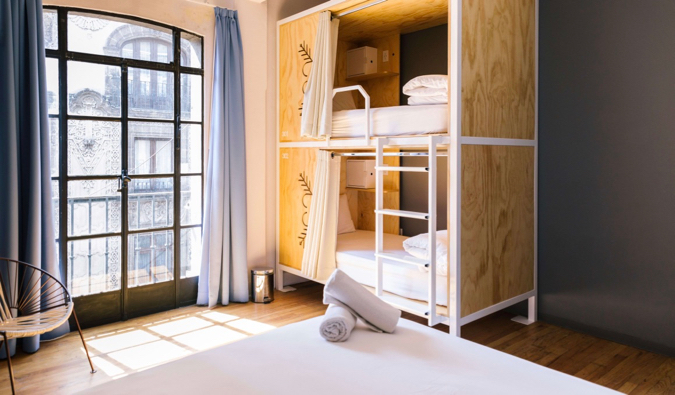 Hands-down the best hostel in the city, Casa Pepe is equal parts cultural hub and boutique hostel. It offers a plethora of activities for travelers like in-house concerts, wrestling trips, tequila tastings, traditional dishes for breakfast, and free daily walking tours in different areas of town too.
The rooms are clean and spacious and come with private lockers. The dorm beds are cubby-like and covered by a curtain, so you can have your own private space, which makes sleeping a lot easier. They also come with their own light and USB charger port. You can enjoy yoga in the morning and relax on the rooftop terrace in the evening (there’s a rooftop swimming pool too!).
If you’re looking for a social hostel that makes it easy to meet people, this is it! It’s also located in a great part of the historic center of the city, near the Metropolitan Cathedral and the Zócalo.
Casa Pepe at a Glance:
Hands-down the best hostel in the city, Casa Pepe is equal parts cultural hub and boutique hostel. It offers a plethora of activities for travelers like in-house concerts, wrestling trips, tequila tastings, traditional dishes for breakfast, and free daily walking tours in different areas of town too.
The rooms are clean and spacious and come with private lockers. The dorm beds are cubby-like and covered by a curtain, so you can have your own private space, which makes sleeping a lot easier. They also come with their own light and USB charger port. You can enjoy yoga in the morning and relax on the rooftop terrace in the evening (there’s a rooftop swimming pool too!).
If you’re looking for a social hostel that makes it easy to meet people, this is it! It’s also located in a great part of the historic center of the city, near the Metropolitan Cathedral and the Zócalo.
Casa Pepe at a Glance:
 Towering over Mexico City, Massiosare El Hostel is located in the penthouse of a beautiful historic building. There’s no elevator up to the hostel (which is on the 4th floor), though, which can be tiring, but it more than compensates with cozy dorm rooms and a super chill rooftop. The views from the roof are incredible, and it’s a fun place to relax at night and listen to music with other travelers.
There are two kitchens (one for vegetarians and one for meat eaters) as well as a free breakfast every morning as well. It’s another great social hostel, and it’s super easy to meet people here. Just make sure to bring earplugs since it’s an old building and sounds tend to carry.
Massiosare El Hostel at a Glance:
Towering over Mexico City, Massiosare El Hostel is located in the penthouse of a beautiful historic building. There’s no elevator up to the hostel (which is on the 4th floor), though, which can be tiring, but it more than compensates with cozy dorm rooms and a super chill rooftop. The views from the roof are incredible, and it’s a fun place to relax at night and listen to music with other travelers.
There are two kitchens (one for vegetarians and one for meat eaters) as well as a free breakfast every morning as well. It’s another great social hostel, and it’s super easy to meet people here. Just make sure to bring earplugs since it’s an old building and sounds tend to carry.
Massiosare El Hostel at a Glance:
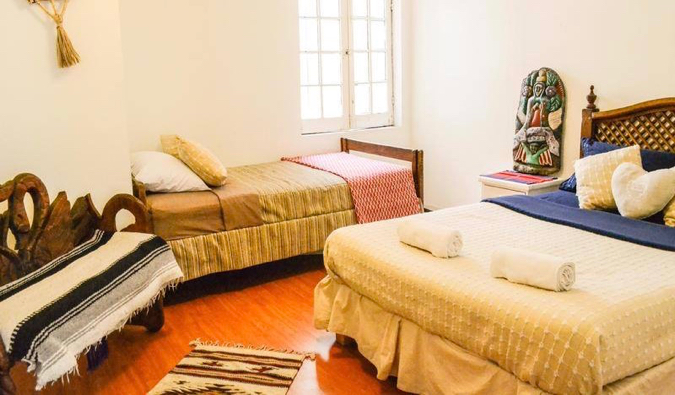 Hostel Home is Mexico City’s first hostel. Located in the Roma district, this place feels is super homey. It’s small, with colorful paintings on the walls and tons of potted plants, and offers comfortable beds, free drinking water, and good Wi-Fi.
The rooms are a little cramped, but each dorm bed has its own locker and power socket, and there’s a large common area in which to socialize in. There’s a kitchen to cook and fresh fruit and eggs are provided at breakfast. The staff are also super helpful and can provide information about the surrounding area and things to do nearby. If you want a more “old school” hostel feel, this place is it.
Hostel Home at a Glance:
Hostel Home is Mexico City’s first hostel. Located in the Roma district, this place feels is super homey. It’s small, with colorful paintings on the walls and tons of potted plants, and offers comfortable beds, free drinking water, and good Wi-Fi.
The rooms are a little cramped, but each dorm bed has its own locker and power socket, and there’s a large common area in which to socialize in. There’s a kitchen to cook and fresh fruit and eggs are provided at breakfast. The staff are also super helpful and can provide information about the surrounding area and things to do nearby. If you want a more “old school” hostel feel, this place is it.
Hostel Home at a Glance:
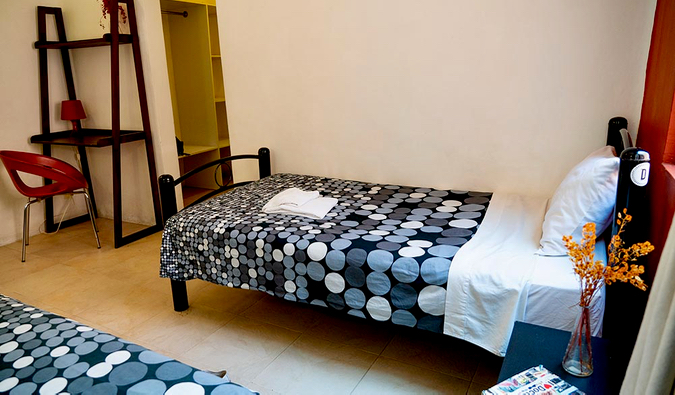 Suites DF Hostel is located in the hustle and bustle of downtown near tons of bars, restaurants, and cafés — although it’s still a bit quieter than other hostels so if you want to avoid a party hostel, stay here.
Overall, the rooms are clean and simple, and the bedsheets have bright, funky designs that brighten up the place. All the dorms have en suite bathrooms, and there is a personal light and power socket for each bed. There are multiple common rooms to hang out in, a cool terrace for relaxing, and free breakfast every morning.
The hostel also offers a lot of awesome tours to see the sights and meet other people. They also arrange trips to the Teotihuacán Pyramids, the Xochimilco Canals, and lucha libre wrestling matches.
Suites DF Hostel at a Glance:
Suites DF Hostel is located in the hustle and bustle of downtown near tons of bars, restaurants, and cafés — although it’s still a bit quieter than other hostels so if you want to avoid a party hostel, stay here.
Overall, the rooms are clean and simple, and the bedsheets have bright, funky designs that brighten up the place. All the dorms have en suite bathrooms, and there is a personal light and power socket for each bed. There are multiple common rooms to hang out in, a cool terrace for relaxing, and free breakfast every morning.
The hostel also offers a lot of awesome tours to see the sights and meet other people. They also arrange trips to the Teotihuacán Pyramids, the Xochimilco Canals, and lucha libre wrestling matches.
Suites DF Hostel at a Glance:
 This hostel is the place to party. The rooftop terrace and bar go until 5:00 in the morning! After spending your night partying, you can soak in the sunshine in the solarium or swing on one of the hammocks.
Dorm rooms are small (only 3 or 4 beds per room). You’ll get towels, a personal locker, and an en suite bathroom. The private rooms are pretty spacious, though, with either a double bed or two single beds. There’s also a delicious free vegetarian buffet breakfast and dinner.
Hostel Amigo Suites Downtown at a Glance:
This hostel is the place to party. The rooftop terrace and bar go until 5:00 in the morning! After spending your night partying, you can soak in the sunshine in the solarium or swing on one of the hammocks.
Dorm rooms are small (only 3 or 4 beds per room). You’ll get towels, a personal locker, and an en suite bathroom. The private rooms are pretty spacious, though, with either a double bed or two single beds. There’s also a delicious free vegetarian buffet breakfast and dinner.
Hostel Amigo Suites Downtown at a Glance: